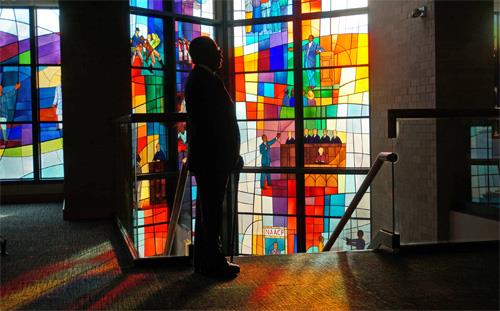
The Black church, like the Black community, isn't the monolithic entity to which it is sometimes reduced in sociological shorthand.
But like the Black community, it has a deceptive strength, and part of that strength stems from its diversity.
The depth of the Black church's roots becomes clear very early in The Black Church: This Is Our Story, This Is Our Song, a four-hour documentary whose first two hours air at 9 p.m. ET Tuesday on PBS (check local listings).
Dr. Henry Louis Gates wrote and hosts the documentary, which harks back to the 17th-century roots of North American slavery, but spends most of its time on the modern church and the integral role it has played in shaping modern society.
Not even slightly by chance, Gates asserts, was the Civil Rights movement of the 1950s and '60s led by ministers like Dr. Martin Luther King Jr.
Fiercely as opponents and critics tried to deny it, their presence affirmed that The Movement was drawing on powers far more timeless and universal than those of mortal man.
In the end, it got too hard to argue that a righteous and just God did not create all human beings equal.
The Black church, This Is Our Story notes, has been making this point since its founding, laying down the unwavering declaration that, as Dr. King famously said, America must work toward the day when its children will be judged by the content of their character rather than the color of their skin.
With that as a foundational throughline, Gates lays out the fascinating and sometimes contentious dramas that have shaped the church – or more accurately, churches – of today.
When the first slaves arrived in the New World, many came from different belief traditions than the Western Christianity that was, by then, more than 1,600 years old.
Western Christianity had not always offered enlightened views on human equality, so the first New World Blacks to embrace Christianity began putting their own stamp on it.
At the same time, the early Black church was less a resistance movement than a refuge, a place of comfort, and perhaps a respite from the cruel realities often enforced by White Christians.
Like the drums in Africa, elements of the Black church evolved into coded messages. Eventually, the Black church became more of an overt base for those seeking change through moral suasion.
Here again, though, the Black church was not a single entity. Gates notes how the African Methodist Episcopal Church (AME) required that its ministers have a formal education so they might better guide others, where the Baptist Church was "congregational," that is, anybody could round up some friends and start a church.
This Is Our Story explores some of the different approaches and philosophical divergence within the Black church while simultaneously acknowledging how its collective institutional power transcended theological disagreements.
This Is Our Story also doesn't shy away from one of King's most disturbing observations, that the Sunday morning worship hour is among the most segregated of the American week. Even philosophically compatible denominations rarely integrate Black and White worshippers.
This is treated here as a powerful reminder of America's historic and ongoing struggle with racial equality.
Perhaps the one area in which there has been significant integration is music.
It's not that Black spirituals like "Swing Low, Sweet Chariot" or "Peace in the Valley" have replaced traditional White Christian anthems, but more that Black gospel music has woven its way into almost all American popular music. When a force is powerful enough, four walls will never hold it in.
The Black Church, in one sense, simply reinforces what millions of Black folks knew already: that it has strengthened its own community and changed America, sometimes at a steep price.